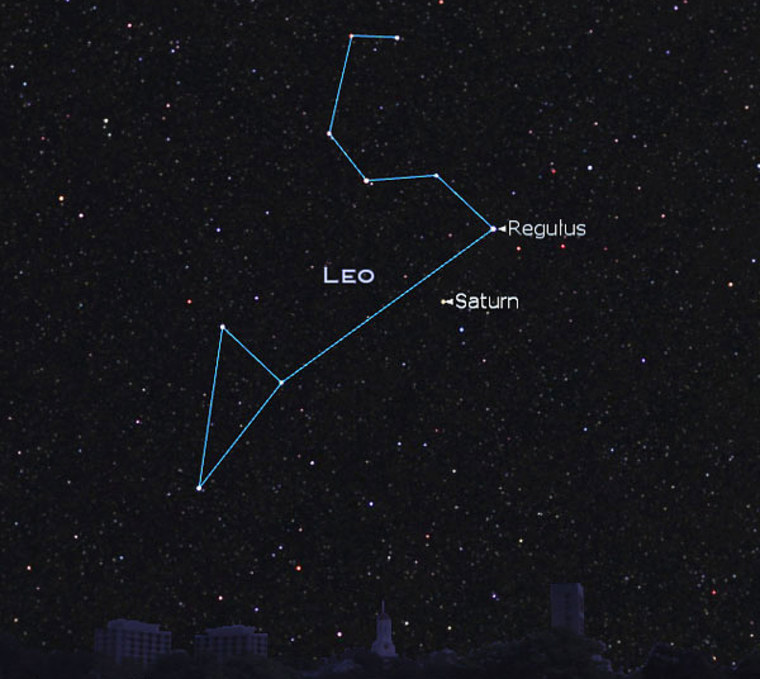Saturn is now at its best in our late-winter sky. It appears below and to the left of the conspicuous "sickle" or backwards question-mark pattern of stars marking the head and mane of the constellation of Leo, the Lion.
It will arrive at opposition to the sun Feb. 24, when it lies on the opposite side of the sky from the sun; rising as the sun sets, reaching its highest point in the southern sky at midnight and setting as the sun rises.
What we see with the naked eye is a bright yellowish-white "star" shining with a steady light. Through a telescope this object is enlarged into one of the finest showpieces of the night sky, thanks to its great ring system in all of its icy, glimmering elegance.
In small telescopes, the rings surprise even veteran observers with their chilling elegance even though it is expected. Certainly they will delight anyone this winter who received a telescope as a holiday gift. Any telescope magnifying more than 30 power will show them.
Look now!
Take a look at Saturn's rings now, because soon our view of them will be compromised by the fact that they are turning more and more edge-on to our line of sight.
Currently the rings are tilted at just over 8 degrees toward us and, actually, they will appear to open slightly to nearly 10 degrees by the beginning of May. However, later this year, the rings will appear to rapidly close up and by the end of this year the tilt of the rings will be less than one degree and they will appear as nothing more than a thin line bisecting the ball of the planet.
And by the late summer of 2009, there will come a period of time when the rings will appear to vanish, as they will be turned exactly edgewise to us.
Some Saturn stats
At an average distance of 886 million miles from the sun, or about twice as far away as Jupiter, Saturn goes around the sun once in 29.5 Earth-years. Second only to Jupiter in size at 74,900 miles, it's more than nine times the size of our Earth. Like Jupiter, it's wrapped in thick clouds which run in parallel bands across its disk.
At last count, Saturn has 61 satellites; the largest one, Titan, appears as a star of eighth magnitude and appears to orbit Saturn in about 16-days.
But the really impressive feature of Saturn is its famous ring system.
These rings are not continuous sheets, but are actually composed of countless billions of particles which range in size from microscopic specks to boulders the size of houses, each one circling like a moon around Saturn and reflecting sunlight. Most of these are composed of water ice.
Through a good-sized telescope the rings appear as two bright ones with a narrow dark space between them — called the Cassini Division, discovered in 1675 — and the fainter "crape ring" nearer to the ball of the planet, which is not quite so easy to see. These are considered the Main Rings and measure about 170,000 miles across, although over the past 30 years several other much fainter rings have been identified from images taken by the Pioneer 11 and Voyager space probes. These are referred to as the Dusty Rings.
The width of the entire ring system, including gaps, is about 258,500 miles.
Galileo was stumped
Galileo Galilei (1564-1642) was the first to view the rings in 1610 although what he saw through his crude telescope left him completely baffled, as Saturn appeared to him not to have rings but rather two smaller bodies flanking it on either side.
He couldn't make them out clearly and thought that Saturn was a triple body, with two small orbs on either side of a large one. Later, when the rings turned edgewise to Earth and the two companions disappeared, Galileo invoked an ancient myth when he wrote, "Has Saturn swallowed his children?" Galileo lamented that his mind was too weak to comprehend this strange phenomenon.
Actually, it was his telescope that was too weak; a better telescope would have revealed Saturn's companions as rings.
It was not until a young Dutch mathematician, Christiaan Huygens (1629-1695), utilized a much better telescope, and on March 25, 1655, saw the rings for what they really were.
Slow, but steady
In mythology, Saturn closely resembled the Greek god Cronus, but he's more usually recognized as the Roman god of agriculture. The name is related to both the noun satus (seed corn) and the verb serere (to sow).
But why would the planet Saturn be linked to agriculture? Perhaps a clue can be found from the ancient Assyrians who referred to Saturn as lubadsagush, which translated, meant "oldest of the old sheep." Possibly this name was applied because Saturn seems to move so very slowly among the stars; it may have also reminded sky watchers of the slow gait of plowing oxen or cattle.
So, if we identify Venus by its great brilliance, Mars by its orange-yellow color and Jupiter which is surpassed only by Venus in brightness, then Saturn is recognized by its slow movement among the stars, and easiest of all, if we examine it through a telescope, by its beautiful rings.
